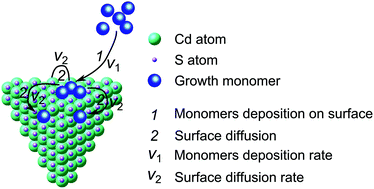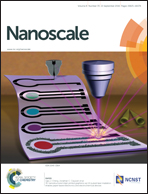Symmetry breaking in semiconductor nanocrystals via kinetic-controlled surface diffusion: a strategy for manipulating the junction structure†
Abstract
The synthesis of semiconductor nanocrystals is usually limited to high-level symmetry, as constrained by the inherent, for example, face-centered cubic or hexagonal close-packed lattices of the crystals. Herein, we report a robust approach for breaking the symmetry of the CdS lattice and obtaining high-quality CdS ultrathin monopods, bipods, tripods, and tetrapods. The success relies on manipulating reaction kinetics by dropwise addition of a precursor solution, which permits deterministic control over the number of CdS monomers in the reaction solution. With rapid monomer supply by fast precursor injection, growth was restricted to only one {111} facet of the nascent CdS tetrahedron to produce an asymmetric ultrathin monopod (a zinc-blende tip with a wurtzite arm). Otherwise, growth monomers could access adjacent {111} facets through surface diffusion and thus lead to the switch of the growth pattern from asymmetric to symmetric to generate an ultrathin multipod (a zinc-blende tip/core with multi-wurtzite arms). These symmetry-controlled photocatalysts were characterized by a fine-tuned zinc blende–wurtzite intergrowth type-II homojunction. After evaluating their structure-dependent solar-hydrogen-production properties, the CdS ultrathin monopod with an appropriate length for controllable charge transportation showed the highest photocatalytic activity.



 Please wait while we load your content...
Please wait while we load your content...